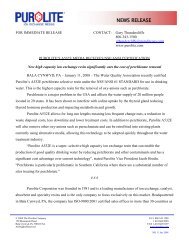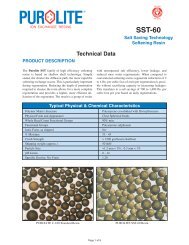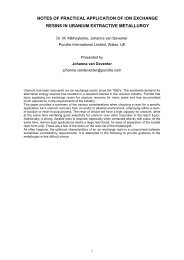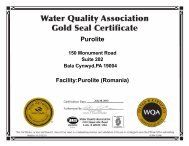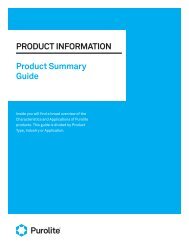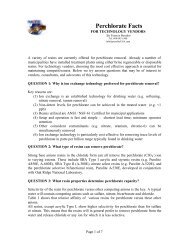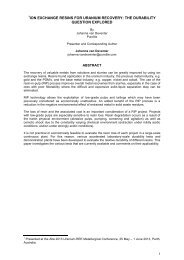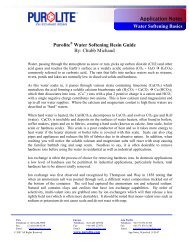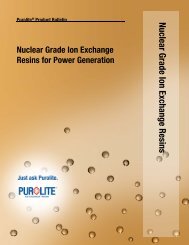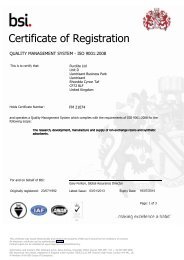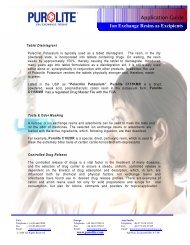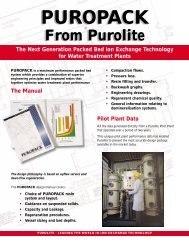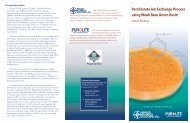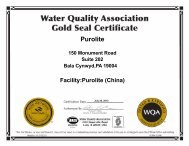Shell core ion exchange resins - Purolite
Shell core ion exchange resins - Purolite
Shell core ion exchange resins - Purolite
- No tags were found...
Create successful ePaper yourself
Turn your PDF publications into a flip-book with our unique Google optimized e-Paper software.
2.5 Weak Acid Resin (WAC) ExampleWAC resin in shell-<strong>core</strong> form was used in simulated hot brine softening withstandard co-flow regenerat<strong>ion</strong>.The regenerat<strong>ion</strong> level was able to be reduced substantially while maintaining ahigher operating capacity than standard WAC resin.Table 13: Hot brine softening (recycling) in lab simulated oil recovery(co-flow HCl regenerat<strong>ion</strong>)Regen. Level Capacity (kg ft -3 ) to 0.2 ppm hardness Heel, ppm, hardnesslb HCl ft -3 Std. Resin <strong>Shell</strong>-Core Resin Std. <strong>Shell</strong>-Core9 (144 g L -1 )6.8 (109 g L -1 )24 350 310.7 02.1 1.42.6 Strong-Base An<strong>ion</strong> Resin (SBA) ExampleAn aggressive synthetic water made by extracting humic soil containing high levelsof SiO 2 , colloidal SiO 2 , and fulvic acid foulant. This was de<strong>ion</strong>ized with parallel two-bedlab systems. One system contained shell-<strong>core</strong> SBA resin (patent pending) in the lagposit<strong>ion</strong>; the other a standard SBA resin.The shell-<strong>core</strong> SBA resin train produced consistently lower silica and fulvic acid leakagethan the parallel system of all standard <strong>resins</strong>. The fulvic acid foulant was regenerated moreeffectively with caustic regenerat<strong>ion</strong> using3 lb NaOH ft -3 (48 g L -1 ) regenerat<strong>ion</strong> levels.Table 14: Aggressive water de<strong>ion</strong>izat<strong>ion</strong>ResinStd. SBA<strong>Shell</strong>-Core SBACapacity,(meqmL -1 )0.300.28Fulvic Acid Leakage(%)112SiO 2 Leakage(%)43Average Cycles: 2 – 5; Water Composit<strong>ion</strong>: SiO 2 =20.5 ppm, Colloidal SiO 2 = 2.3 ppmTOC as Fulvic Acid = 14.3 ppm2.7 Other CharacteristicsThere are a number of accepted accelerated lab tests that predict the stability of <strong>ion</strong><strong>exchange</strong> resin beads. All were used to test the long term stability of shell-<strong>core</strong> (SAC)resin with an appropriate standard resin control. The results show consistently moreresistance by the shell-<strong>core</strong> <strong>resins</strong>, particularly as the S/R ratio decreases.No instance of significant instability of shell-<strong>core</strong> <strong>resins</strong> beads has been reported inseventeen years of commercial use.1. <strong>Shell</strong>-<strong>core</strong> resin decreases in reversible swelling 1 (acid to base cycling) asshell/radius ratio decreases.11



